![]()
![]()
![]()
Use LEFT and RIGHT arrow keys to navigate between flashcards;
Use UP and DOWN arrow keys to flip the card;
H to show hint;
A reads text to speech;
93 Cards in this Set
- Front
- Back
|
Uniformitarianism |
Geological processes have been happening for a long time and will continue to do so. |
|
|
Strata/Stratum |
Layers of the earth. Layer of soil that marks a certain time period in the earth's geological history. |
|
|
Pedestrian Survey |
Walking survey: the practice of walking at even spaces in a line and walking across land looking and marking points of interest for further excavation to come back to. |
|
|
Excavation |
Process of digging and looking for fossils or other points of interest.
Can be done as a test excavation (1M x 1M pit), vertical excavation (keep going deeper) or Hotizontal excavation (spread out in an area and dig certain chunks). |
|
|
Context |
circumstances within which something is found |
|
|
Association |
Spatial relationship that has behavioral, temporal or functional meaning.
|
|
|
Provenience |
Location in 3-D space. |
|
|
Fossil |
Preserved remains that have been dug up. Often will have gone through fossilization, but not necessary. |
|
|
Fossil Record |
Record of fossils we have already found. |
|
|
Fossilization |
Rare process of preservation that requires the right circumstances. Calcium and phosphorous is replaced by silica and iron to create a fossil.
The best environment for a fossil to occur is lacastrine (lake environment). |
|
|
Taphonomy |
Laws of burial: transition of an organism from the biosphere (living) to lithosphere (rock).
Bias in the fossil record that takes into account skeletization, geomorphological/chemical proccesses, root-etching, and biological processes that could prevent any given organism from fossilizing. |
|
|
Relative Chronology |
Places an objective in a timeline in relation to other objects or the stratigraphy it was found in.
Older or younger than another object in a given stratigraphy. |
|
|
Absolute Chronology |
Chronological age estimate for an object. |
|
|
Chemical Dating |
Type of Relative dating that takes into account the degree of chemical absorption over time. |
|
|
Fluorine Dating |
Form of chemical dating that measures fluorine content in bones, was used to determine that neanderthal bones had same amount of fluorine as other animals to know they shared a timeline with them. |
|
|
Tephrostratigraphy |
Form of relative dating that dates objects in relation to the stratum of volcanic ash (tephra). |
|
|
Biostratigraphy |
Dates an object relative to already known animal fossils within the stratigraphy. |
|
|
Seriation |
Also known as cultural dating that dates an object based on cultural advanced of a time period. In relation to human artifacts (tools, weapons, etc.) |
|
|
Radiocarbondating |
Dating the half-life of decay of carbon in an object, but only good for recent fossils as carbon has a short half-life. Anything that was once alive can be radiocarbondated. |
|
|
Radiopotassium Dating |
Dates volcanic eruptions but not living things. Can be used to date fossils trapped between two volcanic layers. |
|
|
Isotope |
Variant forms of an element that differ based on their anatomic weights and numbers of neutrons in the nucleus |
|
|
Half-life |
The time it takes for half of the original amount of an unstable isotope to decay into more stable forms (rate of decay) |
|
|
Parent Isotope |
The original radioactive isotope in a sample
|
|
|
Daughter Isotope |
The isotope that is produced as the result of radioactive decay of the parent isotope |
|
|
Euprimates |
Adapids and omomyids - similar size to lemurs, longer snouts to ommoyids, look like a lemur and had longer tails, lead to the strepsirhines. (eocene) |
|
|
Adapoids |
Species that emerged in the eocene. small eyes; long snout; small incisors, large canines; short tarsal bones |
|
|
Omomyids |
large eyes; short snout; large incisors, small canines; longer tarsal bones |
|
|
Strepsirrhini |
Primarily lemurs |
|
|
Haplorhini |
Tarsiers, monkeys, apes |
|
|
Plesiadapiforms |
Carpolestes one of the plesiadapaforms that was a likely common ancestor to primates. Had a toe on its foot, nail on first foot digit, grasping hands.
Rest of plesiadapiforms did not have these features, had specialized teeth, no post-orbital bar, and so on. More like a cat-rodent thing. |
|
|
Parapithecids |
2133/2133 formula |
|
|
Propliopithecids |
2123/2123 |
|
|
Nuchal Crest |
A bony ridge on the side of the head of certain primates (orangutan) to help give more force for biting. |
|
|
Sagittal Crest |
A bony mohawk especially found in orangutans, it is used to help bite down with more force on tougher morsels. |
|
|
Miocene |
The golden age of hominoids. |
|
|
Oligocene |
New and old world monkeys emerge adaptive radiation as temperatures drop all over the world. |
|
|
Eocene |
Strepsirhines and haplorhines diverge, emergence of first true primates. |
|
|
Paleocene |
First order of primates in this warm temperature time. No true primates yet, but plediadapaforms may have been an early ancestor. |
|
|
Proconsul |
Possible ancestor to the great apes. First example of the y-5 molar pattern. Miocene. Fruit diet, average teeth. |
|
|
Savipithecus |
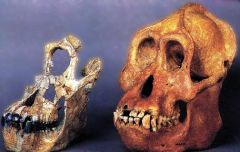
Common ancestor to orangutan from the miocene. Thick enamel for nuts and seeds. concave face, oval eye orbits. |
|
|
New World Monkeys |
Monkeys from South America
2133/2133 average dental formula
Gained a premolar from old world monkeys |
|
|
Old World Monkeys |
Monkeys found in Africa
2123/2123 |
|
|
Taxonomy |
Taxon: Group of organisms with "evolutionary relationships"
Classification of organisms according to |
|
|
Morphology |
Form and structure of an organism either in gross or skeletal anatomy. |
|
|
Phylogeny |
Genetic tree with common ancestors.
Evolutionary relationships between organisms tied either to molecular information or morphological information. |
|
|
Derived Trait |
Characteristics unique to a species. |
|
|
Shared Derived Trait |
Characteristics found in more than one, but not all, descendents, but not in the common ancestor. |
|
|
Ancestral trait |
Characteristics that are shared between organisms. |
|
|
Suture |
A junction that connects the bones (I.E. skull lobes or ox coxae)
Line of junction or an immovable joint between two bones, especially of the skull |
|
|
Appendicular Skeleton |
Limbs and what the limbs are directly connected to. |
|
|
Axial Skeleton |
Skull, ribs, spine, coccyx. |
|
|
Long bones |
arm and leg bones |
|
|
Short bones |
Philanges, metacarpals, etc. |
|
|
Irregular and flat bones |
Pelvis, cranium bones (parietal, temporal, etc.) and other similar bones. Not necessarily "flat." |
|
|
Foramen magnum |
Part of the occipital lobe that the cervical spine fits through. Where head and neck connect. |
|
|
Anterior/Posterior |
Front/Back |
|
|
superior/inferior |
Top/bottom |
|
|
medial/lateral |
Medial (medium) = closer to the center or midline
Lateral = further from the center or midline |
|
|
Proximal/distal |
Proximal = near point of attachment
Distal = Away from point of attachment
Used on limbs |
|
|
Ethology |
Science of animal behavior, study of behavior. |
|
|
Prehensile Tail |
Tail that has adapted to grasp objects (Spider monkeys) |
|
|
Sexual dimorphism |
Physical difference between the sexes of a species. |
|
|
adaptive radiation |
process in which organisms diversify rapidly into a multitude of new forms, especially in climate change. |
|
|
stereoscopic vision |
Seeing an object with both eyes on the same plane, 3-D vision. |
|
|
Bipedalism |
Walking on two legs. |
|
|
Quadrupedalism |
Walking with 4 legs. |
|
|
Brachiation |
Tree-swinging/locomotion. |
|
|
Bilophodant molar pattern |
Molars are broken into two parts. |
|
|
Y-5 Molar pattern |
Y shaped valley in the molars creating 5 parts. |
|
|
diastema |
The over-sized upper canine that sharpens in the premolar honing complex. |
|
|
Infanticide |
Practice of killing infants, mainly to get a female back into heat. |
|
|
material culture |
Culture dealing with material. |
|
|
Early primatologists |
Jane Goodall, Diane Fossey, and Galdikus all met Leaky and pursued anthropology and primate ethology. |
|
|
List a few purposes the bones serve |
- Supports tissues of the body - Structure for body parts and muscles to adhere - Protects soft organs - Reproductive site for red blood cells - produces marrow and calcium - System of levers to move |
|
|
Anatomic position |
Thumbs up, feet forward so the orientation of the limbs are easier to identify. |
|
|
Os Coxae (sketch it) |
Hip bone: ilium, coccyx, pubis, ischium, sacrum |
|
|
General primate characteristics |
Increased brain size to body ratio frontal orientation of enclosed eye orbits front-facing eye orbits for stereoscopic vision grasping hands/grip tactile pads unspecialized dentition decreased reliance on smell nails instead of claws. Opposable thumbs and toes Increased gestation and maturation |
|
|
Key differences between strepsirhini and haplorhini |
Strepsirhini: Rely more on sense of smell, fingers and toes have mixed nails and claws, generally nocturnal, slightly smaller to body ration size compared to Hap. 2133/2133. Primarily lemurs.
Haplorhini: Larger brain to body size, greater sexual dimorphism, color vision, 2132/2132 |
|
|
Dental Formula |
Half of the top over half of the bottom (quadrant over quadrant), expressed like a fraction. ICPM = Incisor, canine, premolar, molar. ICPM/ICPM
|
|
|
Bones in the leg? |
Femur, tibia, fibula, patella, tarsals, metatarsals, phalanges. |
|
|
Bones in the arm? |
Humerous, radius, ulna, clavicle, scapula, carpels, metacarpels, and phalanges. |
|
|
Os Coxae |
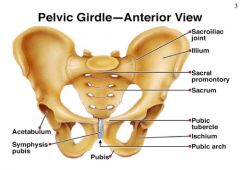
Ilium, Pubis, Ischium
Coccyx, sacrum |
|
|
5 types of vertebrae in the skeleton: |
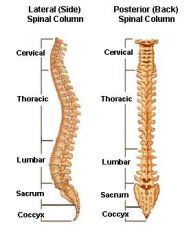
Cervical Thoracic Lumber Sacrum Coccyx |
|
|
Tooth comb |
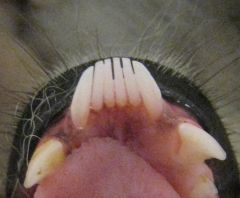
Set of teeth found in lemurs used specifically for grooming (ticks and mites). |
|
|
Canine/Premolar Honing Complex |
The sheering complex that involves the upper canines (enlarged) that sharpen on the lower pre-molar as the jaw of the mouth opens and closes. Gorillas and Baboons are an example of this. |
|
|
Modes of locomotion used by primates (List 7) |
Bracchiation, leaping and clinging, quadrupedal tree climbing/branch walking, knuckle walking on the ground, prehensile tails, bipedalism (humans), slow branch walking. |
|
|
Advantage of a multi-male/female residence pattern? |
Can form together to scare off large predators and other enemies, females compete for resources. |
|
|
What is stratigraphy? |
The study of the order of rock layers and sequences of events they reflect. |
|
|
Law of superposition? |
Layers of rock on the bottom are older than those above it. |
|
|
Mastoid process |
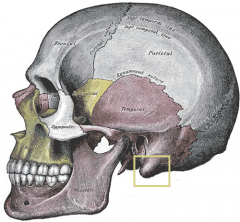
Located below the temporal lobe |
|
|
Radiopottasium dating |
Pottasium parent isotope to argon. The dating of volcanic eruptions based on potassium found in the ground/strata, dates the layers of ash and anything between them. Cannot date fossils. |
|
|
Radiocarbondating |
Measure of the rate of decay or half-life of a carbon from its point of death. Best for newer fossils as carbon decays away quickly. |
|
|
What are the 3 hypotheses for primate evolution? |
Arboreal - Characteristics were selected because arboreal niche opened up and needed filled, and so this introduced grasping hands for brachiating, stereoscopic vision for swinging and leaping in 3-D space, prehensile tails, all of which were adapted for tree-living.
Angiosphere - Larger brain to body ratio adapted to be able to map this plant in the trees and so went to the trees for its abundance.
Visual adaptation - Primates are specialized for preying insects, where depth perception comes into play, can see color to be able to see insects, grasping hands and precision grip helps get insects. This also argues that other animals became arboreal but not like primates did. |

